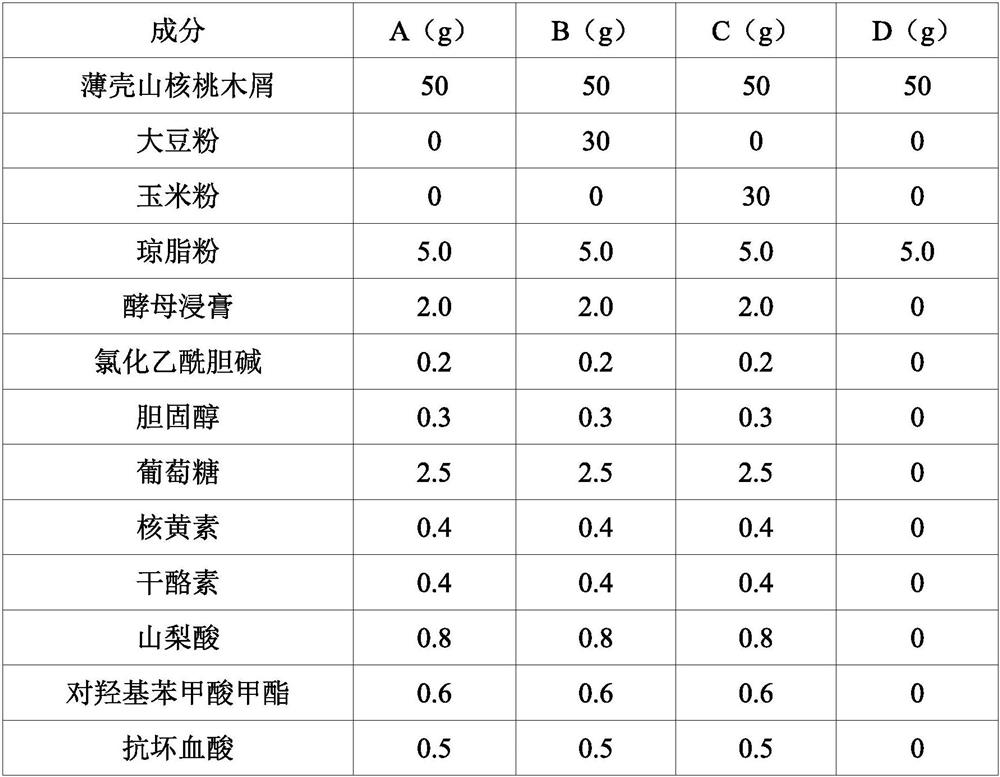A special feed for artificial breeding of coffee wood beetle larvae and artificial breeding method thereof
A technology of wood beetle moth and larvae, which is applied in the field of special feed for artificial breeding of coffee wood beetle larvae, can solve problems such as indoor breeding methods of coffee wood beetle moth that have not yet been seen, and achieve the effect of shortening the pupal period
- Summary
- Abstract
- Description
- Claims
- Application Information
AI Technical Summary
Problems solved by technology
Method used
Image
Examples
Embodiment 1
[0029] 1. Insects to be tested: From May to September 2016, 150 coffee wood beetle larvae were collected from Nanjing Liuhe Lvzhou Thin-shell Pecan Base.
[0030] 2. Feeding method
[0031] 1) Artificial feed preparation
[0032] Collect the 2- and 3-year-old branches of hickory nuts from the wild, remove the bark, cut the rest into pieces of about 1 cm, and put them into a plant grinder to grind them into sawdust. As shown in Table 1, feeds of 4 different formulations of A, B, C and D were prepared. The operation steps are: put quantitative agar powder, yeast extract, acetylcholine chloride, cholesterol, ascorbic acid, glucose, riboflavin, casein, sorbic acid and methyl p-hydroxybenzoate into a 500mL beaker, add 100mL distilled water, Use a digital display constant temperature magnetic stirrer (Shanghai Hannuo Instrument Co., Ltd.) to dissolve it; finally, according to different feed formulas, add quantitative thin-shelled hickory sawdust, soybean flour, and corn flour and ...
Embodiment 2
[0047] The artificial breeding method of coffee wood beetle larvae is the same as in Example 1, wherein two treatments are established at 24° C., darkness, feed B (treatment 1) and 30° C., darkness, feed B (treatment 2), and each treatment is repeated 47 times. Select 94 coffee leopard moth larvae with basically the same physiological state, put one in each glass test tube, and then put them into an incubator with a certain temperature, darkness, and relative humidity of 60% to 70%. The feed was changed every 7 days, the head shell width and body length of the larvae were measured and weighed, the molting, pupation and death of the larvae were closely observed, and the growth and development of each larvae were recorded in detail. The results are shown in Table 3.
[0048] Table 3 Results of different treatments
[0049] deal with processing 1 processing 2 Breeding number (head) 47 47 Number of surviving larvae (head) 42 39 Larval survival rate...
Embodiment 3
[0052] The method of artificial rearing of coffee wood beetle larvae is the same as in Example 1, wherein three treatments were set up in the test, namely treatment 1: dark, 24°C, feed B; treatment 2: indoor natural light, 24°C, feed B; treatment 3: L:D=12:12, 24°C, feed B, each treatment repeated 40 times. Select 120 coffee wood beetle larvae with basically the same physiological state, put one in each glass test tube, and then put them into an incubator at 24°C and a relative humidity of 60% to 70%. The feed was changed every 7 days, the head shell width and body length of the larvae were measured and weighed, the molting, pupation and death of the larvae were closely observed, and the growth and development of each larvae were recorded in detail. The results are shown in Table 4.
[0053] Table 4 - The results of each treatment
[0054]
[0055]
[0056] As can be seen from Table 4, the dark conditions in the light incubator are the most suitable for larvae growth, t...
PUM
 Login to View More
Login to View More Abstract
Description
Claims
Application Information
 Login to View More
Login to View More - R&D Engineer
- R&D Manager
- IP Professional
- Industry Leading Data Capabilities
- Powerful AI technology
- Patent DNA Extraction
Browse by: Latest US Patents, China's latest patents, Technical Efficacy Thesaurus, Application Domain, Technology Topic, Popular Technical Reports.
© 2024 PatSnap. All rights reserved.Legal|Privacy policy|Modern Slavery Act Transparency Statement|Sitemap|About US| Contact US: help@patsnap.com










